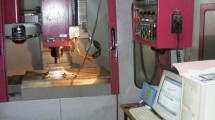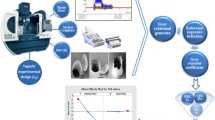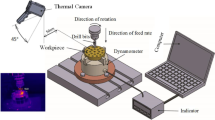Abstract
In this study, the effects of cryogenic treatment and drilling parameters on surface and hole quality were investigated in the drilling of AISI 304 stainless steel under dry drilling conditions. The control factors to provide better surface roughness (Ra) and roundness error (Re) were determined using the Taguchi method. RSM was also used to determine interactions among the control factors. In addition, analysis of variance was employed to determine the most significant control factors on the surface roughness and roundness error. Three drill categories (conventional heat treatment—CHT, cryogenic treatment—CT, cryo-tempering—CTT), cutting speeds, and feed rates were considered as control factors, and an \(\text{ L }_{27}\) full factorial design with a mixed orthogonal array was selected for experimental trials. As a result, it was found that the feed rate and cutting speed were the most significant factors on the surface roughness and roundness error with percentage contributions of 83.07 and 64.365 % respectively. The predictive quadratic models were derived by the RSM to obtain the optimal surface roughness and roundness error as a function of drilling parameters and heat treatments applied to the drills.











Similar content being viewed by others
References
Antonialli, A. I. S., Diniz, A. E., & Pederiva, R. (2010). Vibration analysis of cutting force in titanium alloy milling. International Journal of Machine Tools & Manufacture, 50, 65–74.
Asiltürk, İ., & Neşeli, S. (2012). Multi response optimisation of CNC turning parameters via Taguchi method-based response surface analysis. Measurement, 45, 785–794.
Astakhov, V. P. (2007). Effects of thecuttingfeed, depth of cut, andworkpiece (bore) diameter on thetoolwear rate. The International Journal of Advanced Manufacturing Technology, 34(7–8), 631–640.
Baş, D. H., & Boyacı, İ. (2008). Modeling and optimization I: Usability of response surface methodology. Journal of Food Engineering, 78, 836–845.
Bhatnagar, N., Nayak, D., Singh, I., Chouhan, H., & Mahajan, P. (2004). Determination of machining induced damage characteristics of FRP composite laminates. Materials and Manufacturing Processes, 19, 1009–1023.
Bhattacharya, B., & Sorkhel, S. K. (1999). Investigation for controlled electrochemical machining through response surface methodology based approach. Journal of Materials Processing Technology, 86, 200–207.
Çakır, M. C. (2000). Modern metal cutting methods. Turkey: Bursa.
Cheng, Yu J S H, Chen, X. X., Hung, T. R., & Thibault, F. (2004). Optimization of extrusion blow molding processes using soft computing and Taguchi’s method. Journal of Intelligent Manufacturing, 15, 625–634.
Çiçek, A., Kıvak, T., Uygur, İ., Ekici, E., & Turgut, Y. (2012a). Performance of cryogenically treated M35 HSS drills in drilling of austenitic stainless steels. The International Journal of Advanced Manufacturing Technology, 60, 65–73.
Çiçek, A., Uygur, İ., Kıvak, T., & Altan Özbek, N. (2012b). Machinability of AISI 316 austenitic stainless steel with cryogenically treated M35 HSS twist drills. Journal of Manufacturing Science and Engineering-Transactions of the ASME, 134(6), 061003-1–061003-6.
Cioboata, D. D., Palade, D. D., Abalaru, A., Stancıu, D., Savu, L., Logofatu, C., & TraıstaruIncdmtm, F. (2012). Consıderations regarding evaluation of the accuracy assessment of the roundness. The Scientific Bulletin of VALAHIA University—Materials and Mechanics, nr. 7 (year 10).
Fratila, D., & Caizar, C. (2011). Application of Taguchi method to selection of optimal lubrication and cutting conditions in face milling of AlMg. Journal of Cleaner Production, 19, 640–645.
Gill, S. S., Singh, R., Singh, H., & Singh, J. (2009). Wear behaviour of cryogenically treated tungsten carbide inserts under dry and wet turning conditions. The International Journal of Machine Tools & Manufacture, 49, 256–260.
Göloğlu, C., & Arslan, Y. (2009). Zigzag machining surface roughness modelling using evolutionary approach. Journal of Intelligent Manufacturing, 20, 203–210.
Grum, J., & Slabe, J. M. (2006). The use of factorial design and response surface methodology for fast determination of optimal heat treatment conditions of different Ni–Co–Mo surfaced layers. Journal of Materials Processing Technology, 155, 2026–2032.
Harisha, S., Bensely, A., Lal, D. M., Rajadurai, A., & Lenkey, G. B. (2009). Microstructural study of cryogenically treated En 31 bearing steel. Journal of Materials Processing Technology, 209, 3351–3357.
Horng, J. T., Liu, N. M., & Chiang, K. T. (2008). Investigating the machinability evaluation of Hadfield steel in the hard turning with Al2O3/TiC mixed ceramic tool based on the response surface methodology. Journal of Materials Processing and Technology, 208, 532–541.
Hsiang, S. H., Lin, Y. W., & Lai, J. W. (2012). Application of fuzzy-based Taguchi method to the optimization of extrusion of magnesium alloy bicycle carriers. Journal of Intelligent Manufacturing, 23, 629–638.
Huang, J. Y., Zhu, Y. T., Liao, X. Z., Beyerlein, I. J., Bourke, M. A., & Mitchell, T. E. (2003). Microstructure of cryogenic treated M2 tool steel. Materials Science and Engineering, 339, 241–244.
Islam, M. N., Rafi, N. H., & Charoon, P. (2009). An investigation into effect of canned cycles on drilled hole quality. In Proceedings of the world congress on engineering, Vol I WCE 2009, July 1–3. London, U.K. .
Kıvak, T., Samtas, G., & Cicek, A. (2012). Taguchi method based optimisation of drilling parameters in drilling of AISI 316 steel with PVD monolayer and multilayer coated HSS drills. Measurement, 45, 1547–1557.
Korkut, I., Yavuz, K., & Turgut, Y. (2009). An experimental investigation into the machinability of GGG-70 grade spheroidal graphite cast iron. Indian Journal of Engineering & Materials Sciences, 16, 116–122.
Ko-Ta, C. (2008). Modeling and analysis of the effects of machining parameters on the performance characteristics in the EDM process of Al2O3+TiC mixed ceramic. The International Journal of Advanced Manufacturing Technology, 37, 523–533.
Kurt, M., Bagci, E., & Kaynak, Y. (2009). Application of Taguchi methods in the optimization of cutting parameters for surface finish and hole diameter accuracy in dry drilling processes. The International Journal of Advanced Manufacturing Technology, 40, 458–469.
Lal, D. M., Renganarayanan, S., & Kalanidhi, A. (2001). Cryogenic treatment to augment wear resistance of tool and die steel. Cryogenics, 41, 149–155.
Lalwani, D. I., Mehta, N. K., & Jain, P. K. (2008). Experimental investigation of cutting parameters influence on cutting forces and surface roughness in finish hard turning of MDN250 steel. Journal of Materials Processing and Technology, 206, 167–179.
Liao, H. C. (2005). Using N-D method to solve multi-response problem in Taguchi. Journal of Intelligent Manufacturing, 16, 331–347.
Mandal, N., Doloi, B., Mondal, B., & Das, R. (2011). Optimization of flank wear using zirconia toughened alumina (ZTA) cutting tool: Taguchi method and regression analysis. Measurement, 44, 2149–2155.
Paulin, P. (1993). Frozen gears. Gear Technology, 26–29.
Pilny, L., Chiffre, L. D., Pıska, M., & Villumsen, M. F. (2012). Hole quality and burr reduction in drilling aluminium sheets. CIRP Journal of Manufacturing Science and Technology, 5, 102–107.
Risbood, K. A., Dixit, U. S., & Sahasrabudhe, A. D. (2003). Prediction of surface roughness and dimensional deviation by measuring cutting forces and vibrations in turning process. Journal of Materials Processing Technology, 132, 203–214.
Ross, P. J. (1988). Taguchi technique for quality engineering. New York: McGraw-Hill.
Ross, P. J. (1989). Taguchi techniques for quality engineering loss function, orthogonal experiments parameter and tolerance design. New York: McGraw-Hill International Book Company.
Roy, Ranjit K. (1990). A primer on Taguchi method. New York: Van Nostrad Reinhold.
Sibalija, T. V., & Majstorovic, V. D. (2012). An integrated approach to optimise parameter design of multi-response processes based on Taguchi method and artificial intelligence. Journal of Intelligent Manufacturing, 23, 1511–1528.
Sreerama Reddy, T. V., Sornakumar, T., & Venkatram, R. (2009). Machinability of C45 steel with deep cryogenic treated tungsten carbide cutting tool inserts. International Journal of Refractory Metals & Hard Materials, 27, 181–185.
Suresh, R., Basavarajappa, S., Gaitonde, V. N., & Samuel, G. L. (2012a). Machinability investigations on hardened AISI 4340 steel using coated carbide insert. International Journal of Refractory Metals and Hard Materials, 33, 75–86.
Suresh, R., Basavarajappa, S., & Samuel, G. L. (2012b). Some studies on hard turning of AISI 4340 steel using multilayer coated carbide tool. Measurement, 45, 1872–1884.
Tsaoa, C. C., & Hocheng, H. (2008). Evaluation of thrust force and surface roughness in drilling composite material using Taguchi analysis and neural network. Journal of Materials Processing and Technology, 203, 342–348.
Vitanov, V. I., Javaid, N., & Stephenson, D. J. (2010). Application of response surface methodology for the optimisation of micro friction surfacing process. Surface & Coatings Technology, 204, 3501–3508.
Yang, W. H., & Tarng, Y. S. (1998). Design optimization of cutting parameters for turning operations based on the Taguchi method. Jounal of Materials Processing Technology, 84, 122–129.
Author information
Authors and Affiliations
Corresponding author
Rights and permissions
About this article
Cite this article
Çiçek, A., Kıvak, T. & Ekici, E. Optimization of drilling parameters using Taguchi technique and response surface methodology (RSM) in drilling of AISI 304 steel with cryogenically treated HSS drills. J Intell Manuf 26, 295–305 (2015). https://doi.org/10.1007/s10845-013-0783-5
Received:
Accepted:
Published:
Issue Date:
DOI: https://doi.org/10.1007/s10845-013-0783-5




